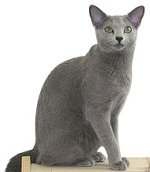|
Russian Blue Cat
Origin Where Russian Blue Cat orginated is a mystery of how it came to be, however stories and legends abound of its origin. A number of people believe the Russian Blue is a naturally occurring breed originating from the Archangel Isles in the northern port of Arkhangelsk, Russia .
Legend has these beautiful animals were trapped for their plush double coats, sometimes compared to the coat of a beaver or seal.
They are may be referred to as Archangel Blues, the Archangel Cat or (historically Foreign Blue.) The belief is they were brought by sailors from the Archangel Isles to England and Northern Europe in the 1860s. It is also rumored the Russian Blue is a descendant of the Royal Cat of the Russian Czars and a favored pet of Queen Victoria.
The first recorded showing of the breed was in 1875 at the Crystal Palace in England as the Archangel Cat. The Russian Blue Cat competed in a class including all other blue cats, until 1912 when this cat was given its own class.
From its early beginnings until after World War II, English and Scandinavian breeders worked to develop the foundation bloodlines for the contemporary Russian Blue. Although the breed was imported to the United States as early as 1900, there is little recorded work with the breed in America until after World War II.
American breeders combined the English bloodlines with their plush, silvery coats and Scandinavian bloodlines with their emerald green eyes and flat profiles to produce the modern Russian Blue Cat we see in the states today. During 1960s the Russian Blue gained popularity and is now a favorite at cat shows and at home.
During the early 1970s, a solid white Russian Blue (called the Russian White) was created by an Australian breeder, Mavis Jones, by the crossing of a Russian Blue with a domestic white cat. By the late 70s, the Russian White and Russian Black colors were accepted by cat fanciers in Australia as Russian cats (in different classes).
In North America, the Cat Fanciers Association does not recognize either variations of the Russian Blue Cat. Only The International Cat Association recognizes the Russian Whites and Russian Blacks and only in the provisional classes.
Behavioral Characteristics
Russian Blue Cats are known for being a very intelligent and tranquil animal, tending to be timid around strangers. They have been known to play fetch and are sensitive to basic human emotions. Sensitive to the temperment of the house, these cats will ‘clown' to quiet a crying baby or sit patting your face to chase away the blues.
They enjoy playing with a variety of toys and they develop extremely close bonds with their human loved ones. The Russian Blue is known for getting along very well with other pets and children in a household. They are known for being quiet, clean cats who are loving and playful companions.
This breed of cat is an excellent choice for the home of today because their undemanding nature fits perfectly into the busy schedules of today. They will entertain themselves when left alone for the day and are a contented companion upon your return.
These cats requires a minimum of grooming with periodic nail clipping and a coat that can be kept looking great by frequent petting and an occasional combing. Many Russians enjoy being combed or brushed this allows them additional time with their owners.
Growth and Maturity
Russian Blues have an average life expectancy of 10–15 years and have few health problems.These cats tend to have little to no genetic problems and are not prone to illness. They are a moderate-sized cat with an average weight of 8-12 pounds when full grown. Males typically are larger than females.
Coloring
The Russian Blue is easily distinguished from other breeds of cats. One of the most prevelant features of the Russian Blue Cat is a short, dense coat of an even, bright blue coloration with each hair dipped in silver. Silver tipping gives the Russian a silvery sheen and lustrous appearance, best appreciated in natural light.
Russian Blues come in only one color, blue and one coat length, short. The density of the coat makes it to stand out from the body, allowing patterns to be traced in the coat which remain until the patterns are smoothed away. In contrast to the blue coat, these cats have large, rounded, wide-set eyes of a vivid green.
The head is may give the appearance of being cobra-like, aptly describing the broad, medium wedge and flat profiles. Large, pointed ears are wide at the base and set rakishly toward the side of the head.
The body is fine-boned, long and firmly muscled. The clean lines and graceful carriage of the Russian Blue give it a regal appearance all its own.
Russian Blues should not be confused with British Blues (which are not a distinct breed but rather a British Shorthair with a blue coat. The British Shorthair breed itself comes in a wide variety of colors and patterns) nor the French Chartreux or Korat which are two other naturally occurring breeds of blue cats, having similar traits.
The Russian Blue may at first glance look like any other gray cat, though a more careful look will show them to have a special appearance that is all their own.
It has been said they look as if they are smiling and why the smile is known only to themselves. Beyond appearances, the real pleasure of the Russian Blue is the unique personality, setting it apart from other cats and making for an interesting, entertaining and affectionate companion to the cats owners and friends. Russian Blue Cat Pictures
|





